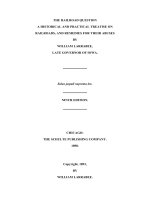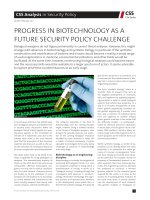Forest tree biotechnology Scott A Merkle and Jeffrey FD Dean
Bạn đang xem bản rút gọn của tài liệu. Xem và tải ngay bản đầy đủ của tài liệu tại đây (87 KB, 5 trang )
298
The past year has seen the fruits of biotechnological manipulation
of forest trees approach commercial application. Advances in
somatic embryogenesis have brought mass clonal propagation of
the top commercial trees closer to reality, and efficient gene
transfer systems have been developed for a number of conifers
and hardwoods. Radical alterations in the quantity and quality of
lignin in wood have been shown to be possible in softwoods and
hardwoods through identification of naturally occurring mutants,
as well as by engineering the lignin biosynthetic pathway with
transgenes. The potential environmental and social impacts of the
release of transgenic trees have become an increasingly
contentious issue that will require more attention if we are to use
these technologies to their full advantage.
Addresses
Daniel B Warnell School of Forest Resources, University of Georgia,
Athens, GA 30602, USA
*e-mail:
†
e-mail:
Current Opinion in Biotechnology 2000, 11:298–302
0958-1669/00/$ — see front matter
© 2000 Elsevier Science Ltd. All rights reserved.
Abbreviations
CAD cinnamyl alcohol dehydrogenase
EST expressed sequence tag
GUS β-glucuronidase
OMT O-methyltransferase
Introduction
Forest trees have undergone relatively little domestication,
consequently biotechnology could potentially have a greater
impact on forestry and forest products than it has had on
agronomic crops. Biotechnological approaches, such as in
vitro propagation, gene transfer and marker-assisted breed-
ing, have done much to bring the genetic improvement of
forest trees to a level of sophistication comparable with that
routinely used for agronomic species. Some of the most
problematic barriers to genetic improvement of forest trees,
such as their large size and long breeding cycles, can be cir-
cumvented by the application of these new techniques.
However, other features inherent to the biology of forest
trees (e.g. the large genome sizes of pines and the recalci-
trance of tissues from mature trees to in vitro manipulation)
continue to present challenges to researchers. Although the
biotechnological improvement of forest trees spans a broad
range of topics, this review will highlight recent progress in
mass clonal propagation of commercial species, new gene
transfer systems, genomics and molecular breeding, lignin
deposition/wood formation, and considerations for the envi-
ronmental release of transgenic trees.
In vitro propagation
The primary applied goal of in vitro culture of forest trees has
always been mass clonal propagation of the most desirable
genotypes, although more recently the provision of target
material for gene transfer has assumed prominence.
Although the first plantlets from forest tree tissue culture
were produced in the 1960s via adventitious shoots, the for-
est industry has more recently focused research efforts on in
vitro propagation via somatic embryogenesis, defined as the
formation of an embryo from a cell other than a gamete or
the product of gametic fusion. This approach appears to
have several advantages over other in vitro propagation sys-
tems, including its potentially high multiplication rates,
potential for scale-up and delivery via bioreactor and syn-
thetic seed technologies, and the fact that embryogenic
cultures make suitable target tissue for gene transfer [1].
Embryogenic cultures have been generated for most com-
mercially important conifers and hardwoods. For the most
part, however, even the best of these systems lack com-
mercial viability for two reasons: firstly, low frequency of
regeneration for many of the most desirable clones; and sec-
ondly, unproven genotypes, as most starting material for the
cultures is derived from seeds or seedlings.
Although much of the work in conifer embryogenesis has
been conducted by forest products company scientists, and
is thus mostly disclosed only in patents, some recent
progress has been reported in the scientific literature.
Research with spruces and pines, in particular, has focused
on improving somatic embryo quality, which should lead to
higher plantlet production rates. Starting from protocols
already patented by industry researchers, treatments with
abscisic acid, polyethylene glycol and maltose were con-
firmed to promote the highest production of mature Pinus
taeda (loblolly pine) somatic embryos [2,3]. Gelling agent
concentration was shown to have an impact on both initia-
tion of pine embryogenic cultures and on maturation of
somatic embryos. Whereas a relatively low concentration
(2 mg/l) of gellan gum was optimal for initiation of embryo-
genic P. taeda cultures [4], a fivefold higher level of gellan
gum aided maturation and germination of somatic embryos
of Pinus strobus [5], Pinus sylvestris and Pinus pinaster [6
•
].
Another surprising finding with P. sylvestris cultures was that
somatic embryos developed and matured spontaneously
with no exposure to exogenous plant growth regulators.
Although encouraging, this progress with somatic embryo-
genesis is still the result of empirical experimentation,
which has long been a hallmark of plant tissue culture
research. Thus, it is highly significant that the past year has
seen the application of a genomics approach to improving
regeneration from forest tree cultures in a more systematic
manner by understanding the developmental changes
occurring in vitro at the gene expression level [7
•
].
The past few years have also seen encouraging progress
with regard to the propagation of proven genotypes via
Forest tree biotechnology
Scott A Merkle* and Jeffrey FD Dean
†
Forest tree biotechnology Merkle and Dean 299
somatic embryogenesis from tissues of mature trees.
Embryogenic cultures of both Pinus radiata (radiata
pine) [8
•
] and Picea abies (Norway spruce; M Pâques,
J Bercetche, L Harvengt, abstract 4, Joint Meeting of the
IUFRO Working Parties 2.04-07 and 2.04-06 Somatic Cell
Genetics and Molecular Genetics of Trees, 12–16 August
1997, Quebec City) were initiated from trees up to 20 and
25 years old, respectively. Although details of the protocols
were not reported, both studies presented evidence that the
material underwent rejuvenation in the process. For hard-
wood species, floral and inflorescence tissues, in particular,
have proven to be useful explants for initiation of embryo-
genic cultures from mature trees [9]. As Eucalyptus species
have risen in economic status, an increasing number of
reports have appeared on in vitro propagation of members of
this genus. Most recently, regeneration of Eucalyptus nitens,
Eucalyptus globulus and a Eucalyptus grandis × Eucalyptus uro-
phylla hybrid was reported via adventitious shoot production
from seedling explants [10,11].
Even with systems for in vitro propagation from mature
tree tissues, in vitro cultures need to be maintained for
years while propagules derived from them are tested in the
field. Serial transfer of cultures over long periods is prob-
lematic due to such factors as labor costs, risk of
contamination, loss of regeneration potential, and
somaclonal variation. With regard to somaclonal variation, a
recent test of 87 embryogenic Picea mariana and Picea glau-
ca clones from which plantlets were regenerated over a five
year period indicated that clonal line and time in culture
were the two most important sources of genetic instability
for the cultures [12]. Fortunately, in vitro cultures, and
embryogenic cultures in particular, have proven amenable
to cryostorage. A set of twelve P. glauca cultures cryopre-
served for 3–4 years and repropagated by somatic
embryogenesis demonstrated general stability with regard
to morphology, in vitro development, ex vitro survival, and
growth characteristics [13]. Random amplified polymor-
phic DNA (RAPD) analysis of another set of P. glauca
embryogenic clones, however, detected a low level of
somaclonal variation within two months following re-estab-
lishment from cryostorage [14].
Development of gene transfer technology
While the first transgenic conifers were generated in the
early 1990s, reports of stable transformation of pine, in par-
ticular, were absent until Walter et al. [15
••
] reported
regeneration of transformed P. radiata plantlets from
microprojectile-bombarded embryogenic cultures. Using
the uidA gene encoding β-glucuronidase (GUS) under the
control of either a double cauliflower mosaic virus (CaMV)
35S promoter or an artificial Emu promoter, more that
150 transgenic radiata pine plantlets were produced from
20 independent transformation events using four different
embryogenic clones. Microprojectile bombardment of
embryogenic cultures has also been used to produce trans-
genic P. mariana [16] and Larix laricina [17] plantlets. In
addition to GUS, green fluorescent protein (GFP) has
recently proven to be a useful reporter for transformation
studies with both conifers and hardwoods [18].
Agrobacterium-Ti plasmid-mediated transformation was
recently achieved for the first time in both Pinus and Picea.
Similar to previous reports for other species, adding extra
copies of genes involved in Agrabacterium virulence and T-
DNA transfer (virG, virB) to disarmed strains of
Agrobacterium tumefaciens, increased transformation effi-
ciencies for embryogenic P. abies cultures 1000-fold, as
determined by GUS expression. A 10-fold increase in
transient GUS expression was obtained using the same
approach with embryogenic P. taeda cultures [19
••
].
Co-cultivation of P. strobus embryogenic tissue with
A. tumefaciens carrying a 35S-35S-AMVgus::nptII fusion
also resulted in the regeneration of stably transformed
somatic embryos [20].
As with conifers, the first report of stably transformed hard-
wood trees is over a decade old, yet additional progress in
transformation of hardwood trees has remained concentrat-
ed to a few genera. Agrobacterium-mediated protocols have
been developed for most Populus species and hybrids [21].
Transformation of one of the top commercial hardwood
genera, Eucalyptus, was recently achieved via co-cultivation
of seedling hypocotyls with A. tumefaciens [22]. One
promising commercial application of transgenic hardwoods
is for phytoremediation, the use of plants to stabilize,
reduce or detoxify pollutants. Liriodendron tulipifera trees
transformed with a modified bacterial mercuric ion reduc-
tase gene were demonstrated to survive on normally toxic
levels of ionic mercury in vitro by reducing it to less toxic
metallic mercury [23
•
].
Genomics and molecular breeding
Two public-domain projects focused on gene discovery in
commercial forest tree species have begun to make informa-
tion available to the wider research community. A pilot study
to characterize expressed sequence tags (ESTs) associated
with wood formation in loblolly pine identified nearly 1100
gene products [24]. This project has been greatly expanded
and as of mid-October 1999 over 5500 EST sequences were
available in a database that may be accessed via the Internet
( />/index.html). A similar project studying wood formation in
Populus compared the expression of more than 5600 ESTs in
xylem and phloem tissues [25]. An Internet-accessible data-
base also exists for the Populus ESTs (http://kiev.
physchem.kth.se/PopulusDB/). In an excellent example of
how such ESTs may be employed to further our understand-
ing of tree biology, an array of several hundred ESTs from
loblolly pine was used to identify differences in the gene
expression patterns that occur during the development of
zygotic and somatic loblolly pine embryos [7
•
]. Such DNA
arrays will provide a powerful tool for rapid optimization of
in vitro culturing techniques for production of high-quality
somatic embryos by helping to identify in vitro conditions
promoting development of zygotic-like qualities.
In the area of molecular markers, initial efforts at compara-
tive mapping of the loblolly and radiata pine genomes
found that a significant number of markers developed in
one species could effectively be used in the other, suggest-
ing that the development of a ‘generic’ pine genetic map
might be possible [26]. Such a generic genetic map could
eventually speed identification and isolation of useful
genes from less-studied pine species. New high-through-
put techniques for quantifying wood properties are being
used in conjunction with genetic maps to identify quantita-
tive trait loci of particular commercial interest [27
•
].
Lignin deposition and wood formation
Considerable excitement has developed recently as sever-
al groups have shown that by manipulating the expression
of genes in the phenylpropanoid pathway, lignin quantity
and composition can be affected much more radically than
was previously expected [28]. Baucher et al. [29] have writ-
ten an excellent review that will serve to update the reader
interested in a more detailed understanding of lignin
biosynthesis and manipulation. Although lignins having
unusual subunit compositions were recognized long ago in
the brown-midrib mutants of monocots [30], the first
strong evidence for what might be possible for lignin mod-
ification in trees came from the identification of a null
allele for the cinnamyl alcohol dehydrogenase (CAD) gene
in loblolly pine [31,32]. Wood from a loblolly pine that was
homozygous for this recessive allele was red-brown in color
and contained elevated levels of soluble phenolic com-
pounds; however, the total lignin content was little
changed. The lignin polymer from this tree also contained
several unusual substituents. Subsequent studies have
shown that the lignin is more easily removed in mild alka-
li treatments and soda pulping, suggesting that alteration
of this gene may hold promise for commercial pulping [33].
Transgenic poplars in which CAD activity was reduced by
up to 70% through the expression of an antisense CAD
gene showed a modest reduction in Klason lignin and
superior pulping characteristics [34].
Angiosperm lignins are more easily extracted from wood
during the pulping process by virtue of their less con-
densed nature resulting from the incorporation of
syringyl residues. This has led to substantial interest in
the possibilities for engineering gymnosperms to express
genes that would produce sinapyl alcohol in addition to
coniferyl alcohol. Angiosperms appear to employ two dif-
ferent classes of O-methyltransferases (OMTs) in the
biosynthesis of lignin precursors; one class acts predom-
inantly on the CoA-thioesters (caffeoyl coenzyme A
3-O-methyltransferase [CCoAOMT]) and the other class
on the free acid (caffeic acid O-methyltransferase
[CAOMT]) forms of the monolignol precursors [35].
Suppression of CAOMT was shown to increase the
coniferaldehyde content of the lignin in transgenic quak-
ing aspen [36], and it made lignin more difficult to
extract from transgenic poplar [34]. Suppression of
CCoAOMT increased the coniferaldehyde content of
the lignin in transgenic tobacco, but this change also
reduced the quantity of lignin in these plants [35]. An
appreciation of the regulatory potential of using CoA-
thioesters as substrates for the biosynthesis of lignin
precursors has also altered our current view of the
5-hydroxylation reaction that immediately precedes the
methylation step. Thus, two laboratories working with
cytochrome P450 monooxygenases from Arabidopsis [37]
and Liquidambar styraciflua (sweetgum) [38] showed that
feruloyl-CoA, rather than ferulic acid, is the most likely
substrate for this critical reaction in the biosynthesis of
sinapyl alcohol. Since the incorporation of sinapyl alco-
hol into angiosperm lignin is considered one of the major
factors enabling easier pulping of hardwoods, there has
been considerable interest in the potential for introduc-
ing the genes for sinapyl alcohol biosynthesis into
gymnosperms. It remains to be seen, however, whether
expression of the appropriate angiosperm hydroxylase
and OMT genes in a gymnosperm will be sufficient to
make softwoods easier to pulp.
Arguably the news that has stimulated the greatest interest
recently came in a report by Hu et al. [39
••
] which showed
that reduced expression of the 4-coumarate:CoA ligase
(4CL) gene in transgenic poplar led to a reduction in lignin
content (up to 45%) and an increased growth rate. These
researchers also claimed a 9–15% increase in cellulose con-
tent and some alteration of hemicellulose composition in
their transgenic lines. These latter claims are open to inter-
pretation, however, because of the small statistical sample
and the authors’ decision to report lignin and cellulose con-
tents as percentages of dry wood weight without also
providing total biomass yields. It will be interesting to see
whether manipulation of the genes encoding other
4-coumarate:CoA ligase isozymes might provide a further
avenue for adjusting lignin composition, as was demon-
strated for Arabidopsis [40].
Environmental considerations
As noted by Mullin and Bertrand [41], the economic
equations that drive investment into the production of
improved forest trees do not always support efforts to
modify wood quality traits, such as lignin extractability,
because returns on that investment cannot be realized
prior to harvest of the improved wood. By contrast, trees
enhanced with genes that provide for gains in growth
and yield are seen to impact profits immediately by
enabling faster rotations. Unfortunately, transgenes for
pest and disease resistance, as well as those for herbicide
and stress tolerance, by their nature improve host fitness,
and thus carry the potential for more far-reaching effects
should they be passed to subsequent generations of feral
trees. Activist groups with agendas that include prohibi-
tion of environmental release of genetically engineered
trees and crops have worked hard to make 1999 a water-
shed year for public opinion, and transgenic trees having
increased fitness have been a prime target for their criti-
cism. The research community ignores public debate on
300 Environmental biotechnology
this topic at its own peril. James et al. [42] have described
potential impacts from escape of such trees, outlined
some potential avenues to decrease the possibility for
such escapes, and have encouraged increased field test-
ing and monitoring. Many of their suggestions were
incorporated into a position statement on the benefits
and risks of transgenic tree plantations adopted by the
IUFRO Working Party on Molecular Biology of Forest
Trees (2.04.06) in September 1999 [43]. Copies of this
statement may be obtained via the Internet
( />Conclusions
Forest tree improvement has heretofore been a slow and
arduous process by virtue of the large size and long genera-
tion times of trees. Biotechnology has now provided tools,
however, that allow us to select and engineer superior trees
with much the same speed and efficiency that can be
applied to other organisms. Consequently, the new millen-
nium is likely to see large and rapid changes in the woody
species used to manufacture paper and solid wood prod-
ucts. Major changes in lignin composition and content have
already been achieved through genetic engineering and the
use of marker-aided selection, and trees with enhanced fit-
ness traits are ready for field testing. However, the impact
that such trees may have on ecosystems when planted on
the plantation scale needs much additional study.
Update
Recent results have shown that diversion of hydroxycinna-
mates into either the lignin biosynthetic pathway or pathways
leading to other secondary metabolites is partially controlled
through complex feedback mechanisms at the enzymatic
level [44]. Thus, levels of coniferyl and 5-hydroxy-
coniferyl aldehydes, intermediates in the latter steps of the
lignin biosynthetic pathway, may govern the activity of the
enzymes necessary for sinapyl alcohol production.
References and recommended reading
Papers of particular interest, published within the annual period of review,
have been highlighted as:
• of special interest
••of outstanding interest
1. Merkle SA, Trigiano RN: In vitro propagation of hardwoods. In
Applications of Vegetative Propagation in Forestry; Proceedings of
the 1992 SRIEG Biennial Symposium on Forest Genetics: 1992
July 8–10; Huntsville, AL. Edited by Foster GS, Diner AM. New
Orleans, LA: USDA Forest Service General Technical Report SO-108:
Southern Forest Experiment Station; 1992:23-37.
2. Li XY, Huang FH, Gbur EE: Polyethylene glycol-promoted
development of somatic embryos of loblolly pine (Pinus taeda L.).
In Vitro Cell Dev Biol Plant 1997, 33:184-189.
3. Li XY, Huang FH, Gbur EE: Effect of basal medium, growth
regulators and Phytagel concentration on initiation of
embryogenic cultures from immature zygotic embryos of loblolly
pine (Pinus taeda L.). Plant Cell Rep 1998, 17:298-301.
4. Li XY, Huang FH, Murphy JB, Gbur EE: Polyethylene glycol and
maltose enhance somatic embryo maturation in loblolly pine
(Pinus taeda L.). In Vitro Cell Dev Biol Plant 1998, 34:22-26.
5. Klimaszewska K, Smith DR: Maturation of somatic embryos of
Pinus strobus is promoted by a high concentration of gellan gum.
Physiol Plant 1997, 100:949-957.
6. Lelu MA, Bastien C, Drugeault A, Gouez ML, Klimaszewska K:
• Somatic embryogenesis and plantlet development in Pinus
sylvestris and Pinus pinaster on medium with and without growth
regulators. Physiol Plant 1999, 105:719-728.
This study shows that for P. sylvestris (and potentially for other conifers), all
steps of embryogenesis, from induction to maturation, can occur without any
exposure to plant growth regulators, and that manipulation of gellan gum
concentration can improve pine somatic embryo maturation.
7. Cairney J, Xu NF, Pullman GS, Ciavatta VT, Johns B: Natural and
• somatic embryo development in loblolly pine — gene expression
studies using differential display and DNA arrays. Appl Biochem
Biotechnol 1999, 77-9:5-17.
Over 400 ESTs identified by differential display as having altered expression
patterns during loblolly pine zygotic embryo development were used to pro-
duce macroarrays. These macroarrays were used to monitor the expression
of genes during somatic embryo development under varied culture condi-
tions to look for conditions that would more closely mirror the gene expres-
sion patterns in developing zygotic embryos.
8. Smith DR: Successful rejuvenation of radiata pine. In Proceedings
• of the 25th Biennial Southern Forest Tree Improvement Conference:
1999 July 11–14; New Orleans, LA. New Orleans, LA: Southern
Forest Tree Improvement Committee; 2000: in press.
This study is the first report of induction of somatic embryogenesis from tis-
sues (apical meristems) of mature pine trees, and provides an excellent
example of the economics of applying such an approach for selectively prop-
agating mature trees based on their individual fiber properties.
9. Merkle SA, Battle PJ: Enhancement of embryogenic culture initia-
tion from tissues of mature sweetgum trees. Plant Cell Rep 2000,
19:268-273.
10. Bandyopadhyay S, Cane K, Rasmussen G, Hamill JD: Efficient plant
regeneration from seedling explants of two commercially impor-
tant temperate eucalypt species — Eucalyptus nitens and E. glob-
ulus. Plant Sci 1999, 140:189-198.
11. Cid LPB, Machado ACMG, Carvalheira SBRC, Brasileiro ACM: Plant
regeneration from seedling explants of Eucalyptus
grandis
××
E urophylla. Plant Cell Tiss Org Cult 1999, 56:17-23.
12. Tremblay L, Levasseur C, Tremblay FM: Frequency of somaclonal
variation in black spruce (Picea mariana, Pinaceae) and white
spruce (P. glauca, Pinaceae) derived from somatic embryogene-
sis and identification of some factors involved in genetic instabil-
ity. Am J Bot 1999, 86:1373-1381.
13. Park YS, Barrett JD, Bonga JM: Application of somatic embryogen-
esis in high-value clonal forestry: development, genetic control,
and stability of cryopreserved clones. In Vitro Cell Dev Biol Plant
1998, 34:231-239.
14. DeVerno LL, Park YS, Bonga JM, Barrett JD: Somaclonal variation
in cryopreserved embryogenic clones of white spruce [Picea
glauca (Moench) Voss.]. Plant Cell Rep 1999, 18:948-953.
15. Walter C, Grace LJ, Wagner A, White DWR, Walden AR,
•• Donaldson SS, Hinton H, Gardner RC, Smith DR: Stable
transformation and regeneration of transgenic plants of Pinus
radiata D. Don Plant Cell Rep 1998, 17:460-468.
The first published report of stable genetic transformation and regeneration
of any pine. Microprojectile bombardment of embryogenic cultures with con-
structs carrying NPTII and GUS, followed by selection on geneticin was
used to obtain transformed embryogenic material from which transgenic
somatic seedlings were regenerated.
16. Charest PJ, Devantier Y, Lachance D: Stable genetic-transformation
of Picea mariana (black spruce) via particle bombardment. In
Vitro Cell Dev Biol Plant 1996, 32:91-99.
17. Klimaszewska K, Devantier Y, Lachance D, Lelu MA, Charest PJ: Larix
laricina (tamarack) — somatic embryogenesis and genetic trans-
formation. Can J Forest Res 1997, 27:538-550.
18. Tian LN, Levee V, Mentag R, Charest PJ, Seguin A: Green fluores-
cent protein as a tool for monitoring transgene expression in for-
est tree species. Tree Physiol 1999, 19:541-546.
19. Wenck AR, Quinn M, Whetten RW, Pullman G, Sederoff R: High
•• efficiency Agrobacterium-mediated transformation of Norway
spruce (Picea abies) and loblolly pine (Pinus taeda). Plant Mol Biol
1999, 39:407-416.
Evidence is presented that manipulation of vir genes can enhance
Agrobacterium-mediated transformation of conifers, such as Norway spruce
and loblolly pine embryogenic cultures.
20. Levee V, Garin E, Klimaszewska K, Seguin A: Stable genetic
transformation of white pine (Pinus strobus L.) after cocultivation
Forest tree biotechnology Merkle and Dean 301
of embryogenic tissues with Agrobacterium tumefaciens. Mol
Breed 1999, 5:429-440.
21. Han KH, Meilan R, Ma C, Strauss SH: An Agrobacterium
transformation protocol effective on a variety of cottonwood
hybrids (genus Populus). Plant Cell Rep 2000, 19:315-320.
22. Ho CK, Chang SH, Tsay JY, Tsai CJ, Chiang VL, Chen ZZ:
Agrobacterium tumefaciens-mediated transformation of
Eucalyptus camaldulensis and production of transgenic plants.
Plant Cell Rep 1998, 17:675-680.
23. Rugh CL, Senecoff JF, Meagher RB, Merkle SA: Development of
• transgenic yellow poplar for mercury phytoremediation. Nat
Biotechnol 1998, 10:925-928.
Yellow-poplar trees engineered with a modified bacterial mercuric ion reduc-
tase gene via microprojectile bombardment of embryogenic cultures were
capable of surviving on medium with up to 50 µM ionic mercury by reducing
it to less toxic metallic mercury.
24. Allona I, Quinn M, Shoop E, Swope K, St Cyr S, Carlis J, Riedl J,
Retzel E, Campbell MM, Sederoff R, Whetten RW: Analysis of xylem
formation in pine by cDNA sequencing. Proc Natl Acad Sci USA
1998, 95:9693-9698.
25. Sterky F, Regan S, Karlsson J, Hertzberg M, Rohde A, Holmberg A,
Amini B, Bhalerao R, Larsson M, Villarroel R et al.: Gene discovery in
the wood-forming tissues of poplar: analysis of 5,692 expressed
sequence tags. Proc Natl Acad Sci USA 1998, 95:13330-13335.
26. Devey ME, Sewell MM, Uren TL, Neale DB: Comparative mapping in
loblolly and radiata pine using RFLP and microsatellite markers.
Theor Appl Genet 1999, 99:656-662.
27. Tuskan G, West D, Bradshaw HD, Neale D, Sewell M, Wheeler N,
• Megraw B, Jech K, Wiselogel A, Evans R et al.: Two high-throughput
techniques for determining wood properties as part of a
molecular genetics analysis of hybrid poplar and loblolly pine.
Appl Biochem Biotechnol 1999, 77-79:55-65.
Computer tomography X-ray densitometry and pyrolysis molecular beam
mass spectrometry were used to analyze the specific gravity and composi-
tion of wood from 375 hybrid poplars and 172 loblolly pines, each of which
represented segregating progeny from a three-generation pedigree. Eleven
quantitative trait loci linked to specific wood components and two quantita-
tive trait loci linked to multiple components were mapped in loblolly pine.
28. Sederoff RR, MacKay JJ, Ralph J, Hatfield RD: Unexpected variation
in lignin. Curr Opin Plant Biol 1999, 2:145-152.
29. Baucher M, Monties B, Van Montagu M, Boerjan W: Biosynthesis
and genetic engineering of lignin. Crit Rev Plant Sci 1998,
17:125-197.
30. Halpin C, Holt K, Chojecki J, Oliver D, Chabbert B, Monties B,
Edwards K, Barakate A, Foxon GA: Brown-midrib maize (bm1) — a
mutation affecting the cinnamyl alcohol dehydrogenase gene.
Plant J 1998, 14:545-553.
31. MacKay JJ, OMalley DM, Presnell T, Booker FL, Campbell MM,
Whetten RW, Sederoff RR: Inheritance, gene expression, and
lignin characterization in a mutant pine deficient in cinnamyl
alcohol dehydrogenase. Proc Natl Acad Sci USA 1997,
94:8255-8260.
32. Ralph J, MacKay JJ, Hatfield RD, O’Malley DM, Whetten RW,
Sederoff RR: Abnormal lignin in a loblolly pine mutant. Science
1997, 277:235-239.
33. MacKay J, Presnell T, Jameel H, Taneda H, O’Malley D, Sederoff R:
Modified lignin and delignification with a CAD-deficient loblolly
pine. Holzforschung 1999, 53:403-410.
34. Lapierre C, Pollet B, Petit-Conil M, Toval G, Romero J, Pilate G,
Leple JC, Boerjan W, Ferret V, De Nadai V, Jouanin L: Structural
alterations of lignins in transgenic poplars with depressed cinnamyl
alcohol dehydrogenase or caffeic acid O-methyltransferase activity
have an opposite impact on the efficiency of industrial kraft
pulping. Plant Physiol 1999, 119:153-163.
35. Zhong RQ, Morrison WH, Negrel J, Ye ZH: Dual methylation
pathways in lignin biosynthesis. Plant Cell 1998, 10:2033-2045.
36. Tsai CJ, Popko JL, Mielke MR, Hu WJ, Podila GK, Chiang VL:
Suppression of O-methyltransferase gene by homologous sense
transgene in quaking aspen causes red-brown wood phenotypes.
Plant Physiol 1998, 117:101-112.
37. Humphreys JM, Hemm MR, Chapple C: New routes for lignin
biosynthesis defined by biochemical characterization of
recombinant ferulate 5-hydroxylase, a multifunctional cytochrome
P450-dependent monooxygenase. Proc Natl Acad Sci USA 1999,
96:10045-10050.
38. Osakabe K, Tsao CC, Li LG, Popko JL, Umezawa T, Carraway DT,
Smeltzer RH, Joshi CP, Chiang VL: Coniferyl aldehyde
5-hydroxylation and methylation direct syringyl lignin biosynthesis
in angiosperms. Proc Natl Acad Sci USA 1999, 96:8955-8960.
39. Hu WJ, Harding SA, Lung J, Popko JL, Ralph J, Stokke DD, Tsai CJ,
•• Chiang VL: Repression of lignin biosynthesis promotes cellulose
accumulation and growth in transgenic trees. Nat Biotechnol
1999, 17:808-812.
Transgenic aspen in which xylem-specific 4-coumarate:coenzyme A ligase
(4CL) was repressed by an antisense gene had a 45% reduction in lignin
content. The trees also had thicker stems, longer internodes, larger leaves,
and their cuttings showed better rooting than controls.
40. Lee D, Meyer K, Chapple C, Douglas CJ: Antisense suppression of
4-coumarate:coenzyme A ligase activity in Arabidopsis leads to
altered lignin subunit composition. Plant Cell 1997, 9:1985-1998.
41. Mullin TJ, Bertrand S: Environmental release of transgenic trees in
Canada — potential benefits and assessment of biosafety. Forestry
Chron 1998, 74:203-219.
42. James RR, DiFazio SP, Brunner AM, Strauss SH: Environmental
effects of genetically engineered woody biomass crops. Biomass
Bioener 1998, 14:403-414.
43. Strauss S, Boerjan W, Cairney J, Campbell M, Dean J, Ellis D,
Jouanin L, Sundberg B: Forest biotechnology makes its position
known. Nat Biotechnol 1999, 17:1145.
44. Li L, Popko JL, Umezawa T, Chiang VL: 5-hydroxyconiferyl aldehyde
modulates enzymatic methylation for syringyl monolignol
formation, a new view of monolignol biosynthesis in
angiosperms. J Biol Chem 2000, 275:6537-6545.
302 Environmental biotechnology









